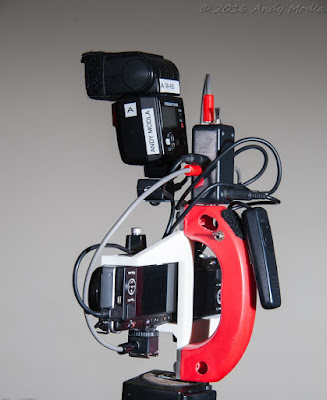UPDATED: 2016-10-11
What features should you look for when selecting a camera to make a 3D twin camera rig?
I'm asking the question so I can have a checklist for upgrading my current 3D twin camera rig, pictured above, that is more than 3 1/2 years old. It uses two Olympus E-PM2 cameras. The checklist is based on my personal experiences with three home-made twin camera rigs I built and used so far. The other two rigs used Nikon D-80 (purchased 2007) and Canon PowerShot SD800 (purchased 2006, point and shoot) cameras. I bought the Olympus cameras in 2013. Usually I buy the second camera used to lower the cost.
Here are ten features I think you need in a camera to build a twin camera stereo 3D rig:
- Live view
- It's too cumbersome to use a viewfinder to compose your shot when using twin cameras.
- Capture the "moment" faster because you can see both eye views at the same time when composing a shot.
- Touch screen focus point selection (without releasing the shutter)
- Offset twin cameras will not focus on the same subject in your shot, so you need a way to quickly set the same subject focus point for both cameras.
- Touching the screen should not release the shutter, the camera menu should have the option to not take the photo when you touch the screen.
- Lens not in the center of the camera
- Look for lens mount close to one side of the camera
- This lens offset makes it possible to give you the smallest inter-axial separation possible for close subjects when one camera is upside down using a Z-bar mount.
- Small and lightweight camera
- You will carry the rig all day, therefore lighter is better.
- Small cameras usually provide smaller inter-axial separation too.
- Interchangeable lenses
- You can use a prime lens and not worry if each camera built-in lens has the same zoom setting
- Change lens to suit scene and subject
- Wide angle lens provide more depth of field than telephoto lenses
- Remote focus and shutter trigger connection
- Wired
- Input remote trigger connector should be on side opposite where two cameras are joined together for the smallest possible inter-axial camera separation.
- Use a simple direct wire OR diode circuit to release the shutter without any delays, when the camera is already focused. Diodes isolate the shutter release circuits in each camera. See http://www.rmm3d.com/3d.encyclopedia/twin.camera/sync.html
- Note that the focus control line must also have a wire OR diode circuit.
- Bluetooth wireless shutter/focus release, if available, allowing you to use two selfie remote Bluetooth triggers wired together.
- Optical IR focus/shutter release remote control (Nikon)
- WiFi remote focus/shutter trigger control of multiple cameras.
- Flash shoe
- Must be able to use off camera flash, no compromises here.
- Must be able to select 1st curtain flash trigger for use with an external circuit controller, that allows you to synchronize flash triggers from each camera and use an off camera flash.
- One camera may have to be mounted upside down using a Z-bar mount and support
- Live view must appear upside, when the camera is upside down.
- Menu setting displays you have to make while setting the camera should not appear upside down.
- JPEG and Raw photo files
- Need Raw files for post processing to adjust left and right camera file exposure and color differences
- Post processing produces better photos many times especially to fix noise issues from high ISO settings
- Camera with both manual settings and fully automatic settings
- Olympus iAuto feature is very helpful when shooting events with many changing brightness levels. Look for a camera with intelligent auto settings.
- For some scenes you don't have time to change any camera settings.
- Other times you want manual settings for full control, such as a studio setting.
- When the light source is off to the side, one of the images will be under exposed when using automatic settings and will need post processing.
My current 3D rig with twin Olympus E-PM2 does everything except 6.2, 6.3, and 8.2. The flash unit in the photo below is about 10 inches above the cameras and is centered for balance. Instead of the flash unit I usually use a PocketWizard wireless controller to trigger off camera strobes.




